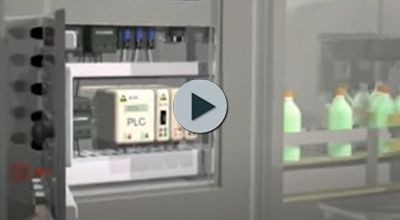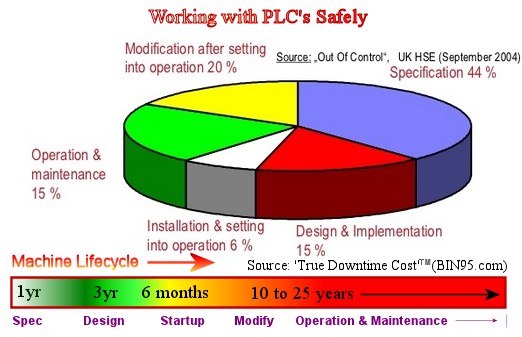Ensure Your PLC Safety & Reliability
What Is A Commonly Overlooked Safety And Reliability Area Affecting the Entire Facility?
I'll give you a clue: it has the letters "PLC" in it. You have probably guessed what it is by now: the Programmable Logic Controller. And even more so is the next technological advancement to the PLC, the PAC (Process Automation Controller), but I'll talk about that later. It is not the PLC itself that is the problem, as they are highly reliable devices; how we work with PLCs makes our systems so much less reliable.
The PLC controls just about every machine, industry, and country, yet it is the last item that plant maintenance and engineering do reliability analysis on. If the reliability issues related to PLCs are considered at all. What is even more surprising and even less known is that the PLC also controls most of the world's infrastructure. The PLC controls most of the world's power, water, traffic lights, trains, elevators, big building's HVAC, and much less critical equipment like boilers, bridges, tunnels, hospital incinerators, combines, car crushers, and more.

Better safety and reliability in your car than in your machine:
The PLC is like your car's "Brain Box" (Electronic Control Unit - ECU) in that it is an 'out of sight, out of mind' little black box until the car breaks down. The difference is that when your car's ECU indicates a problem, you have a technician trained and certified on that unit to work with it. When a machine or other PLC-controlled system indicates a problem, most have an electrician or engineer with little training in that specific PLC work on it. There are also other differences. An ECU typically affects one piece of equipment costing less than $40k. A PLC typically affects one or many machines, costing $100k to millions. But more importantly, an ECU affects the reliability of one machine (car) and one person's safety. A PLC can affect the reliability and safety of many machines and many people.
So, how is Safety and Reliability put at risk when working with PLCs?
- Lack of training
- Lack of policies and procedures
- Complacency
- Lack of security
The above four causes of safety and reliability risks associated with PLCs are in order of importance. The primary cause of risk while working with a PLC is a need for proper training. Because technology in manufacturing and related industries evolves almost as quickly as the computer industry, more than textbook training is required to qualify an individual to work with PLCs. (Especially since the textbooks are out of date by the time they get printed. But more importantly, companies must incorporate safety and reliability policies and procedures into the training and company policy. Company policy must dictate that only those "properly trained" be allowed to work with the PLCs. Employees receive refresher training and are qualified yearly to avoid complacency and keep up with technological advancements. With PLCs, lack of security was a rare cause of safety and reliability risk in the past. However, with more networking of PLCs to other devices, the risk has been steadily increasing. With the evolution of the newest controller, the PAC, the risk is climbing exponentially.

Those seasoned vets in our industry know how to specify and design both PLCs and automated equipment to cover safety adequately. We also realize that safety risks increase considerably during the commissioning phase, working with the PLCs and automated equipment, especially with PLCs/PACs. Most of the industry still needs to safely work with PLCs/PACs for the other 90% of the automation equipment lifecycle.
Another critical PLC safety point is made evident in the chart above. While the pie chart shows modifications and MRO are only 35% of the picture, it does not consider the life of the equipment or automation control system. Looking at the linear chart below, you see that 35% MRO and occasional modifications of the machine/ system continue for 10-25 years of the equipment's lifecycle. Another way to view it is 35% times 90% of the equipment's lifecycle! All of a sudden that 35% becomes an astronomical risk neglected over the life of the equipment!
Safety and reliability get worse with new technology:
With PACs (Process Automation Controllers), all four safety and reliability risk categories increase. Primarily because of inadequate training on the new technology. But equally so because of the way PACs are designed. PLCs mimic electrical circuits, making them easier for the electrician to work with. Conversely, the PAC combines the PLC with motion control and other technologies, including computer programming. A company will not likely find an electrician with a computer programming-related degree. If they do, they most likely will not be able to pay the required wage for such a skilled person. Or the other way around, a computer programmer willing to do electrical work and trained on PLCs.
At least complacency is not an issue with the relatively new PAC, as most find it overly complex and confusing. However, security risks dramatically increase because of the ever-growing use of Ethernet and even the internet to access PACs. Maintenance and engineering are less likely to know and take computer communication security steps and procedures. IT personnel are less likely to understand the concept and reality of a PAC on their network, which is more complex than just backing up the program. Breaches in PAC/PLC security don't just crash a program; they can crash a machine, causing damage to a real-world man or machine!
Oh, the stories I can tell.
Oh, the stories I can tell.
I advise companies to get annual PLC training that includes safety and reliability. Just as importantly, get policies and procedures that include PLCs/PACs.
I would also highly recommend you read the article "Managing PLCs in your Facility"
About the Author:
Don Fitchett is President of Business Industrial Network (BIN), an Industrial training company specializing in PLC training. Don has held that position for over 25 years and has been in the industrial training industry for over 30 years.
